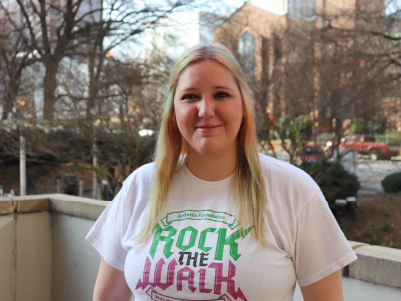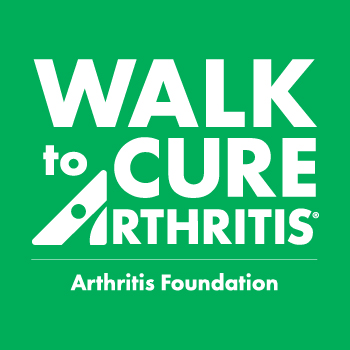Arthritis Warrior Says It's Possible to Live a Normal Life
Walk to Cure Arthritis national honoree Amanda Watt spreads hope while fighting ankylosing spondylitis.
By Allison Wilcosky | March 23, 2023
 Amanda Watt was diagnosed with ankylosing spondylitis (AS) at 26 years old, but her pain started when she was 10 or 11.
Amanda Watt was diagnosed with ankylosing spondylitis (AS) at 26 years old, but her pain started when she was 10 or 11.
“I remember sitting, and my elbows would get really stiff if I didn't move them,” she says. “My mom took me to the doctor and, of course, they said, ‘It's growing pains, she's fine.’” In high school, Amanda started having bad back pain and, by the time college rolled around, the pain would flare up and be so severe that she’d go to the ER. From there, she saw doctor after doctor, trying to find answers, but it was her ophthalmologist who gave her the clarity she needed. “When I told her my back was flaring when I was on steroids, my eyes started to flare, too,” Amanda continues. “She said, ‘Based on your records, I think this is what you have,’ and she sent me to a rheumatologist.”
“I was very excited I finally had answers, but it didn’t change anything. I had all the symptoms before; it’s just getting a name so I can get treatment.”
“It takes 10 to 12 years for a diagnosis of AS. That’s why I want to get my story out there,” Amanda says. She also wants to break down any misconceptions about the disease, particularly one that stuck with her that she heard from a doctor. “I was actually told by a pain doctor that ankylosing spondylitis was a man’s disease, and she didn’t know why I had it.”
In 2023, she was told by a doctor that she also most likely had psoriatic arthritis.
Highs and Lows
Amanda works in clinical research, around cancer and sickle cell, and has spent most of her career working with kids. “When I found opportunities helping kids with chronic illnesses, I thought that would have been great for me to have — someone who understood what I was going through and who I could talk to,” she says. “I loved talking with the kids to get their minds off what was going on. I like to share those things with patients.”
“I think it also helped the parents see that ‘you deal with chronic pain and illnesses, but you’re still able to have a job and have a life. It’s not just going to be in the hospital and doctors’ appointments. You can still succeed.’” Amanda has had to step back from working with patients directly, due to her AS. But she hopes that, one day, more and better pain treatment options become available so that she can get back to that.
She walks regularly and stretches to keep her pain under control, as well as spends time with her friends to take her mind off her symptoms. But it can be a challenge.
“When I am at my worst, I don't see people. So, even my close friends don't really understand how bad it is. Just because I don't have something physical you can see, like a missing limb, doesn’t mean I’m not in pain.”
Getting Involved
Amanda first crossed paths with the Arthritis Foundation through Alpha Omicron Pi (AOII), where she was the philanthropy chair in her local chapter. Then through her job, she found Foundation-sponsored research studies that she and others she knew could participate in. But her first direct involvement was with Walk to Cure Arthritis. Her first walk event in 2020 was virtual, but she proved to be a dynamic fundraiser and champion for the cause with her team. In 2023, she was named the national adult honoree.
Amanda was asked to help on the Arthritis Foundation Georgia office’s planning committee in 2022 and was also the local adult honoree that same year. “During the Walk, a lot of people came up to me,” she remembers. “I was hard to miss. I had bright pink hair. They recommended a lot of different things. It’s a community where people not only offer support but provide resources, too. I became friends with a couple of people after that.”
When Amanda found out she was the national adult honoree, she was thrilled. “I started calling everyone, I was so excited. My family and friends were so excited for me, my parents especially. They get to see I can use my experience to help others and not be laying in a bed miserable for myself.”
Through it all, Amanda empathizes with others on their journeys and has only a message of hope. “My one takeaway would be that, despite dealing with hardships and chronic illness, you can push through and live a fairly normal life. You can still live a normal life despite your struggles, because everybody has struggles, just in different ways.”
 Amanda Watt was diagnosed with ankylosing spondylitis (AS) at 26 years old, but her pain started when she was 10 or 11.
Amanda Watt was diagnosed with ankylosing spondylitis (AS) at 26 years old, but her pain started when she was 10 or 11. “I remember sitting, and my elbows would get really stiff if I didn't move them,” she says. “My mom took me to the doctor and, of course, they said, ‘It's growing pains, she's fine.’” In high school, Amanda started having bad back pain and, by the time college rolled around, the pain would flare up and be so severe that she’d go to the ER. From there, she saw doctor after doctor, trying to find answers, but it was her ophthalmologist who gave her the clarity she needed. “When I told her my back was flaring when I was on steroids, my eyes started to flare, too,” Amanda continues. “She said, ‘Based on your records, I think this is what you have,’ and she sent me to a rheumatologist.”
“I was very excited I finally had answers, but it didn’t change anything. I had all the symptoms before; it’s just getting a name so I can get treatment.”
“It takes 10 to 12 years for a diagnosis of AS. That’s why I want to get my story out there,” Amanda says. She also wants to break down any misconceptions about the disease, particularly one that stuck with her that she heard from a doctor. “I was actually told by a pain doctor that ankylosing spondylitis was a man’s disease, and she didn’t know why I had it.”
In 2023, she was told by a doctor that she also most likely had psoriatic arthritis.
Highs and Lows
Amanda works in clinical research, around cancer and sickle cell, and has spent most of her career working with kids. “When I found opportunities helping kids with chronic illnesses, I thought that would have been great for me to have — someone who understood what I was going through and who I could talk to,” she says. “I loved talking with the kids to get their minds off what was going on. I like to share those things with patients.”
“I think it also helped the parents see that ‘you deal with chronic pain and illnesses, but you’re still able to have a job and have a life. It’s not just going to be in the hospital and doctors’ appointments. You can still succeed.’” Amanda has had to step back from working with patients directly, due to her AS. But she hopes that, one day, more and better pain treatment options become available so that she can get back to that.
She walks regularly and stretches to keep her pain under control, as well as spends time with her friends to take her mind off her symptoms. But it can be a challenge.
“When I am at my worst, I don't see people. So, even my close friends don't really understand how bad it is. Just because I don't have something physical you can see, like a missing limb, doesn’t mean I’m not in pain.”
Getting Involved
Amanda first crossed paths with the Arthritis Foundation through Alpha Omicron Pi (AOII), where she was the philanthropy chair in her local chapter. Then through her job, she found Foundation-sponsored research studies that she and others she knew could participate in. But her first direct involvement was with Walk to Cure Arthritis. Her first walk event in 2020 was virtual, but she proved to be a dynamic fundraiser and champion for the cause with her team. In 2023, she was named the national adult honoree.
Amanda was asked to help on the Arthritis Foundation Georgia office’s planning committee in 2022 and was also the local adult honoree that same year. “During the Walk, a lot of people came up to me,” she remembers. “I was hard to miss. I had bright pink hair. They recommended a lot of different things. It’s a community where people not only offer support but provide resources, too. I became friends with a couple of people after that.”
When Amanda found out she was the national adult honoree, she was thrilled. “I started calling everyone, I was so excited. My family and friends were so excited for me, my parents especially. They get to see I can use my experience to help others and not be laying in a bed miserable for myself.”
Through it all, Amanda empathizes with others on their journeys and has only a message of hope. “My one takeaway would be that, despite dealing with hardships and chronic illness, you can push through and live a fairly normal life. You can still live a normal life despite your struggles, because everybody has struggles, just in different ways.”

Join the Movement
Find your local Walk to Cure Arthritis and sign up to help find better treatments and a cure for the millions of adults and children living with arthritis.
